If you haven’t noticed, electric mountain bikes are here to stay. In just a few short years, most mountain bike companies have added an assisted steed to their lineup as the category continues to evolve and mature. And for good reasons: it’s the fastest-growing segment of mountain bikes, and they happen to be pretty darn fun to ride. Looking at the shortlist of companies that have yet to produce an electric bike in 2022, most riders are probably wondering when the fine folks at Transition Bikes will join the party. The rider-owned Pacific Northwest brand is synonymous with producing bikes that foster good times and hard-charging riding, so why not add a motor into the mix?
Well, try to act a little surprised because today, Transition has finally jumped on the electric bandwagon with the release of their all-new Repeater e-bike. Developed to take you where your mountain bike can’t, the Repeater features 160mm of travel, 29-inch wheels, and Shimano’s trusted EP8 motor. With balanced geometry that doesn’t tip the scales too far in any direction, the Repeater is a ride-everything machine that may win over some stubborn e-haters.
Strengths |
Weaknesses |
|
|
|
Highlights
- Full carbon frame
- 29-inch wheels (no mullet configuration available)
- 160mm (6.3-inches) rear wheel travel // 160mm (6.3-inches) fork travel
- GiddyUp suspension design
- No geometry adjustments
- 64-degree head angle
- 455mm chainstay length
- Fits 1.5 or 1.8-inch steerer tube forks
- 630Wh Shimano battery
- 85Nm Shimano STEPS EP8 motor
- Shimano STEPS SC-EM800 display
- FOX Factory 38 GRIP 2 fork
- FOX Factory Float X2 shock
- DT Swiss HX1700 Hybrid wheels
- Magura MT7 brakes
- OneUp dropper post
- 29x2.4-inch Schwalbe Magic Mary Addix Ultra Soft front tire
- 29x2.4-inch Schwalbe Big Betty Addix Soft rear tire
- Boost 12x148mm rear hub spacing
- Molded chainstay protector
- Sizes: small, medium, large, X-large
- Measured weight (size large, no pedals): 50.2lbs (22.7kg)
- MSRP: $8,199-$10,999 USD

Developing the Repeater
When a brand decides to dive into the electric assist realm, it takes years to arrive at a finished product. For Transition, they were riding e-bikes to build trails and for filming projects long before the prospect of developing their own was realized. Taking the time to sample the landscape allowed them the opportunity to observe firsthand what other brands were doing and better understand how e-bikes differ from typical mountain bikes.

When it came time to invest energy into developing the Repeater, Transition knew they wanted their e-bike to excel across varied terrain and prioritize descending or climbing performance equally. Often, e-bikes are marketed as ‘the shuttle killer,’ meaning that their greatest character trait is their ability to climb more and faster. This isn’t the sole narrative that Transition aimed for with the Repeater. Instead, they wanted to create a bike that’s primary goal was to unlock new terrain that you otherwise wouldn’t experience on a mountain bike. And while you are exploring new trails with lots of unknowns, having a bike suited for various situations was paramount. Transition also knew that balancing weight and battery capacity was crucial to creating an e-bike that allowed riders to achieve long, exploratory riders without negatively affecting handling and maneuverability. To accomplish these ride qualities, Transition settled on 160mm of travel both front and rear with a Shimano 630 watt-hour battery and similar geometry to their Sentinel trail bike.


With 160mm of travel, the Repeater is equipped with enough suspension to navigate demanding descents while efficiently carrying speed through undulating terrain or up technical climbs. To solve the weight to battery range to maneuverability equation, Transition went with Shimano’s 630 watt-hour battery. At this size, the Repeater has plenty of juice for all-day adventures and weighs in at a manageable 50.2-pounds (varies depending on build). Finally, Transition’s Sentinel trail bike has been their do-it-all, 150mm travel trail bike for years now and its balanced geometry provided the perfect starting point to mold the Repeater from.
Frame Details
Transition has continually fine-tuned the aesthetics and details of their carbon bikes, and the Repeater is their latest rendition, sharing many similarities with their other models. The frame has a lifetime warranty and is constructed from Japanese Toray fiber. The main pivot uses the same collet design found on all Transition frames, which helps keep pivot hardware tight and shields the bearings from water contamination. All frame pivots also use EnduroMAX pivot-specific bearings. The drive-side chainstay features a sleek but sufficient molded rubber guard to minimize chain slap, while accessory mounts can be found on the underside of the top tube.




The headtube of the Repeater is oversized to accommodate a 1.5-inch or 1.8-inch tapered steerer tube fork. Transition did this to better blend the oversized width of the downtube with the headtube and to accommodate internal cable routing through the steerer tube. All cables enter through the top of the Acros headset cover before slotting between the inside of the downtube and the battery. The battery can be removed with a 4mm hex wrench, exposing the cables for easy replacement. On the outside of the battery is a removable cover that fits flush within the frame opening to limit debris from making its way inside the frame. Finally, the Repeater features no geometry adjustments or mullet configuration options.

Geometry
As mentioned, the Repeater strikes the most geometry similarities with its Sentinel sibling. However, Transition did not simply bolt a Shimano EP8 motor to the bottom bracket of their Sentinel and call it a day. The Repeater was designed from the ground up, and Transition aimed for middle ground with geometry measurements to achieve a bike that will hold its own both climbing and descending.

The head angle comes in at 64-degrees which is a hair steeper than the Sentinel at 63.6-degrees. Transition says the added weight from the motor and battery keeps the Repeater planted and stable during descending, requiring a less steep head angle. The effective seat angle is also steeper across all sizes on the Repeater compared to the Sentinel, shifting rider weight forward over the bike for improved pedaling efficiency. We find this ever so crucial on an e-bike because with the assist of a motor comes the ability to claw your way up previously unimaginable climbs. We also find that we climb more often with our seat post at half-mast on e-bikes, and the steeper seat angle keeps our body centered over the pedals.

Across all sizes, the reach of the Repeater is about 5mm longer than the Sentinel, while the stack height is around 9mm taller. Combined with the lower center of mass from the motor, these two factors have a huge effect on stability and comfort. Lastly, the Repeater has long, 455mm chainstays across all sizes, which are a healthy 15mm longer than the chainstays on the Sentinel. This was done to accommodate a 29-inch rear wheel around the motor and suspension layout while also improving traction when climbing and overall stability.
GiddyUp Suspension Design
The Repeater uses Transition’s tried and true GiddyUp suspension system. The four-bar, horst link design provides a predictable mix of small bump compliance, mid-stroke support, and subtle bottom-out resistance. The Repeater offers 25.9% of overall progression at a linear rate of change, slightly higher than the Sentinel’s 25% progression. Transition recommends between 28-34% sag (18-22mm), giving riders the freedom to set up the Repeater to match their riding style.

Shimano EP8 Motor, 630Wh Battery and E-TUBE App
The Repeater is equipped with Shimano’s latest EP8 motor that boasts 85Nm of smoothly delivered torque. When the EP8 motor launched, Shimano introduced multiple updates that built on the success of their STEPS E800 motor. Most notably, the EP8 motor is now smaller, lighter, and more powerful, with a redesigned internal layout that reduces overall drag when pedaling. Shimano also quickened the motor cut-out time when riders stop pedaling, making the assistance more predictable during technical climbs. Lastly, about 5mm was shaved off the height of the EP8 motor for better ground clearance. But just in case you do make contact with the ground, the Repeater also features a plastic skid plate.

The Repeater is fitted with Shimano’s 630 watt-hour battery integrated into the downtube and removed via a 4mm hex key. On the non-drive side can be found the charging port for easy on-bike charging. Shimano says it takes two hours to achieve 50% battery charge and around six hours to reach full charge. This rang true throughout testing, with most charging taking place overnight to ensure a full battery for rides the following day. It’s worth noting Transition is using a stock Shimano battery so that riders globally who purchase a Repeater can have their battery serviced by their local Shimano Service Center.

One of the highlights of the EP8 system is the ability to customize and fine-tune the motor output to match rider preference via Shimano’s E-TUBE app. Two ride profiles can be created for the EP8 motor with power output, support level, and sensitivity adjusted individually for Eco, Trail, and Boost modes. Riders can then toggle between the two profiles via the onboard display. Riders can also perform system updates within the app, check battery health, and configure onboard display modes. Lastly, Shimano’s E-TUBE Ride app can be used during rides to display real-time data, view maps, and record routes that can then be uploaded to Strava.


Build Kits
The Repeater is available from size small through X-large, with three build kits to choose from in the Mossy Green colorway. Across all three builds, the Repeater uses Shimano’s EP8 motor, 630 watt-hour battery, and full color E800 display as well as a OneUp dropper post, Magura brakes, Schwalbe Super Gravity tires, and 38mm stanchion forks. We commend Transition for maintaining quality e-bike rated components across all their builds.

The most expensive Repeater AXS build retails for $10,999 USD, with the GX build coming in at $9,499 USD, followed by the NX build at $8,199 USD. Due to component availability difficulties, our test bike was made up of parts from the AXS and GX builds, featuring a FOX Factory 38 fork and Float X2 shock, OneUp carbon handlebars, Magura MT7 brakes, SRAM GX Eagle drivetrain and DT Swiss HX 1700 wheels.



On The Trail
Our journey with the Repeater began back in October with a wet and chilly trip to Bellingham, Washington, to visit Transition. Over our five-day trip, we were welcomed with three days of consistent downpours and less than ideal conditions to shake down a new bike. Luckily, Transition recently moved into a badass new building complete with a full-service bike shop, badass showroom, and beer on tap. We highly recommend stopping by if you find yourself in Bellingham! While we waited for the inclement weather to pass, we spent a few afternoons wandering the halls for old history and spent lots of time discussing their new e-bike.






When the wet weather receded, we spent two days playing in the mud, exploring lesser-known areas of Bellingham. The trails we rode were certified gnarly in both directions, and you would never find us riding such trails on a mountain bike. Many of the loops were out and backs, snaking down steep ravines before climbing back up rut infested single track. With no shortage of sloppy topsoil, roots, motorcycle ruts, rock slabs, and the occasional natural double, we quickly understood the terrain that Transition had designed the Repeater around.

After our trip up north, we returned with soggy shoes and lots of trail envy to finish off testing in our backyard of Boise, Idaho. With only a short window of riding available before winter dropped its white cloak over our trails, we split testing between e-bike legal motorcycle trails and The Basin Gravity Park. After years of dirt bike traffic, our local moto trails provide endless high-speed, sweeping turns and long straightaways riddled with rollers and square-edge bumps. The perfect concoction to see how the Repeater would handle compressions at full speed. Balancing out our white-knuckle moto trails was The Basin Gravity Park, which offers a mix of flowy bike park jump trails and steep, tight technical sections.

Descending Performance
It’s no secret that Transition designs bikes to maximize a rider’s experience on descents, and the Repeater maintains this ideology. While the geometry might now be as progressive as some of Transition’s other models, the combination of low hung weight and 160mm of travel front and rear make the Repeater an incredibly comfortable, stable, and planted e-bike ready to smash gnarly descents.

We tested a large Repeater with a healthy 480mm reach and tall 640mm stack height. These two geometry numbers fit our body size perfectly and placed our center of mass evenly over the bike. We probably use the phrase ‘sat in the bike’ too often, but the high stack allowed us to drive our weight through our heels while the roomy reach pulled our torso forward with our elbows flared outward. This body position gave us an incredibly stable base from which we could easily react and direct the Repeater during rowdy descents. As most riders can relate, if you feel restricted and can’t shift your weight over your bike, it becomes difficult to ride fast or confidently. This is not the case with the Repeater. From our first ride, we felt right at home pushing the limits of the bike, knowing that as our speed increased, stability and comfort would remain constant.
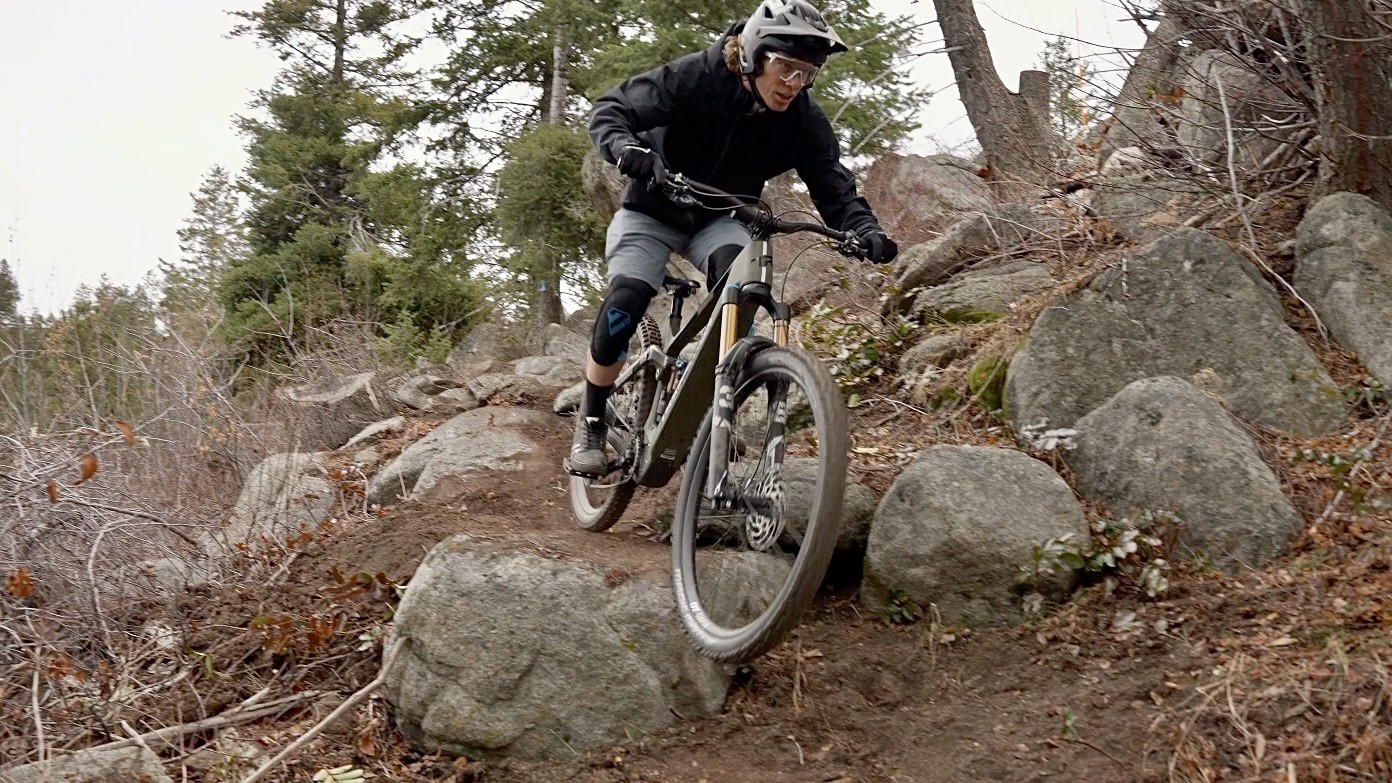
Adding to the stability of the Repeater was the increased weight from Shimano’s EP8 motor, making the bike feel glued to the ground through small bump chatter. As dedicated flat pedal riders, this made keeping our feet secured to the pedals effortless. The low center of mass also helped lock the Repeater into turns and maintain predictable traction. There is no better feeling than blazing through a corner on rails without fear of breaking grip with the ground!
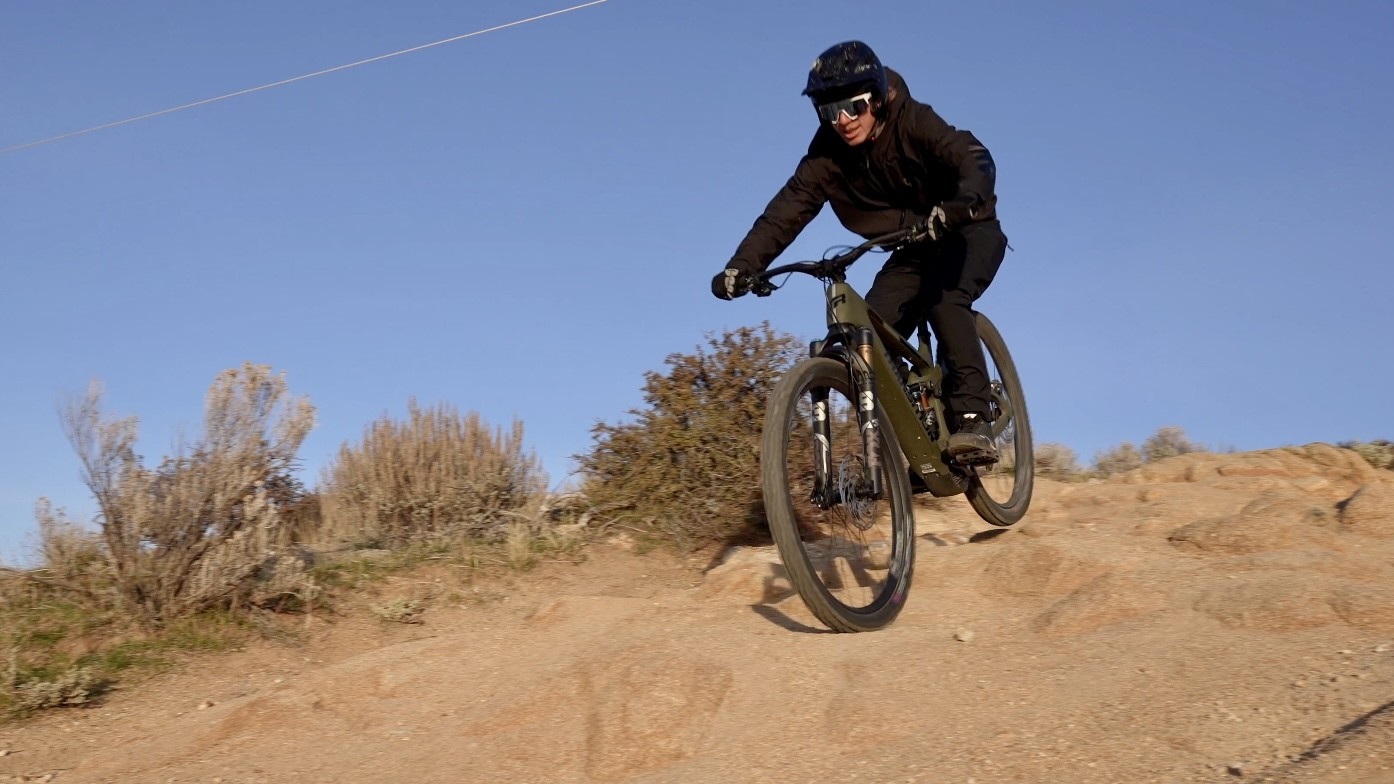
Another huge factor that made the Repeater such a confidence-inspiring tank to rally down trails was the long, 455mm chainstays. With the rear axle far behind our body weight, the bike tracked in a straight line with ease, and the rear end rarely kicked out on us. The downside to so much bike outback was the amount of effort it took to manual or bunny hop the Repeater. We also noticed a lack of maneuverability in really tight and slow sections. Of course, a 50-pound e-bike isn’t supposed to be the most nimble, and we would rather reap the benefits of longer chainstays to help manage the size of the Repeater and sacrifice some agility.

While we loved how planted the Repeater rode across various trail conditions, the downside to such a large and in-charge e-bike was how slow the bike responded to ride input. This was most noticeable on gradual descents or bike park flow trails, where pumping and pedaling were mandatory to maintain speed. We’ve talked about this sensation before with e-bikes and the Repeater shined most on trails with a high average speed where the weight and stability of the bike could be maximized.
Climbing
When it came to climbing ability, the Repeater excelled at transferring power from the EP8 motor into forward momentum thanks to its long chainstays and steep seat tube angle. Our large Repeater had a 77.4-degree effective seat tube angle which positioned our weight considerably forward during climbs. This allowed us to keep the cranks spinning without worrying about the front wheel lifting or the rear wheel losing tractions. Even when taking on steep, slick, technical climbs, the Repeater was continuously impressive, always finding grip and remaining composed. However, we found the bike’s overall length problematic during tight and tricky climbs. The Repeater was simply too long to maneuver around switchbacks on a few occasions. These instances were far and few between, but something to keep in mind if your trails are filled with slow-moving, challenging climbs.
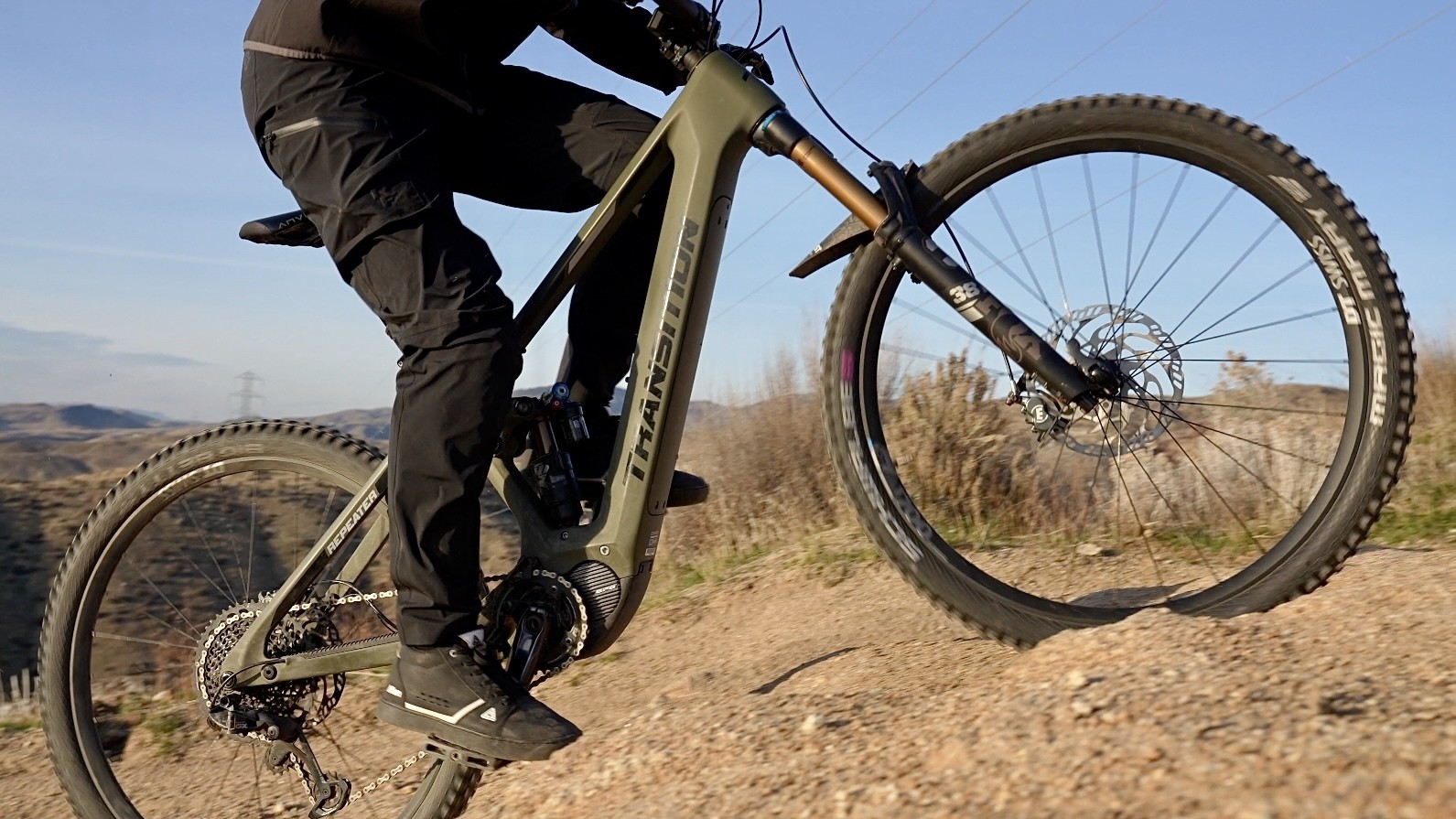
Rear Suspension Performance
The Repeater’s GiddyUp suspension design provided an incredibly supple and calm ride thanks to its small bump sensitivity and linear rate of progression. We’ve talked a lot about how stable and planted the Repeater remained during descents, and this comfort was felt the most during the first three-quarters of travel. We spent the most time riding in this portion of travel and enjoyed the Repeater’s ability to smooth out varying compression sizes in a predictable manner.
When we plowed into large compressions at higher speeds, we noticed that the Repeater would bottom out easier than we preferred. If additional high-speed, large compression continued, the suspension would begin to pack up at bottomed out. Thanks to its sheer size and weight, the Repeater still held its own through super rough sections, but the rear suspension struggled to maintain a plush ride.

Luckily, one of the highlights of a four-bar horst-link design is the ability to easily fine-tune suspension performance to match rider preferences. To compensate for the limited bottom-out resistance, we ran the FOX Factory Float X2 rear shock with 30% sag, high and low-speed compression about halfway closed, and installed one additional air volume reducer. This setup gave the Repeater more ending-stroke support without negatively affecting the supple, active feel earlier in the travel.

When climbing, Transitions’ GiddyUp design remained quite firm around sag and under pedaling forces but still provided enough small bump sensitivity to maintain traction and comfort. The suspension also manages square edge impacts well without getting caught up or bobbing and causing a loss of momentum. Due to how calm the Repeater remained when climbing, we rarely used the lockout switch on the Factory Float X2 shock.

Shimano EP8 Motor Performance
Shimano’s EP8 motor packs a serious punch that makes just about any climb achievable. The power delivery is quick without being too snappy, and the torque on offer can almost be overbearing in technical sections. While some e-bike motors allow the rider to spin the cranks and receive unfiltered power, the EP8 motor is very cadence-dependent. We found the sweet spot when pedaling the Repeater was between 85rpm and 100rpm. At this cadence, our efforts were matched with the highest motor output.

When our cadence would drop below 85rpm, the lack of assistance was very noticeable, and the motor would feel like it was dragging us down. This phenomenon rang true in all assist modes. Maintaining a cadence higher than we typically would on a mountain bike did require plenty of cardio endurance that had us breathing heavily for the duration of climbs. We enjoyed being able to get a solid workout in when riding the Repeater, but for riders who are looking to kick back and glide up climbs, the EP8 motor might not get the job done for you.
E-TUBE App Customization
Out of the box, Transition presets the Repeater with two profiles riders can toggle between within Shimano’s E-TUBE app. We spent all our time in Profile 1, which we appropriately titled ‘QUICKER.’ In this assist configuration, the max torque of each mode is higher than what Shimano typically presets the EP8 motor with, and Trail mode is only one notch below Boost mode. The only change we made was moving Eco mode from 42Nm to 49Nm.



On the trail, these adjustments made Eco and Trail mode more usable and improved our battery range. We spent most of our time climbing in Trail and enjoyed the ability to use Boost for exceptionally steep climbs or jump down to Eco on flat traverses while still receiving adequate assistance.
630 Watt-hour Battery Range
Now, before we get into battery life, do understand that factors such as rider weight, terrain, and rider effort can affect battery range outside of just how many watt-hours the battery contains. Shimano provides an estimated range for each assist mode with a full charge, but we usually achieve fewer miles than predicted.

We had two loops we frequented the most with the Repeater. The first loop was just over 12-miles (19.3km), with 2,500-feet of fire road climbing, and would take about an hour to complete. With the battery fully charged and riding most of the time in Trail mode, we would finish the loop with two or three bars (out of five) remaining. The second loop was around 17-miles (27.3km), with 3,500-feet of mixed fire road and single track climbing, and would take around two hours to complete. With the battery fully charged and riding in mostly Trail or Boost mode, we would typically finish the loop with the one bar of battery remaining. Again, these are averages from two examples, and we did experience mild fluctuations in battery life depending on our cadence and effort.
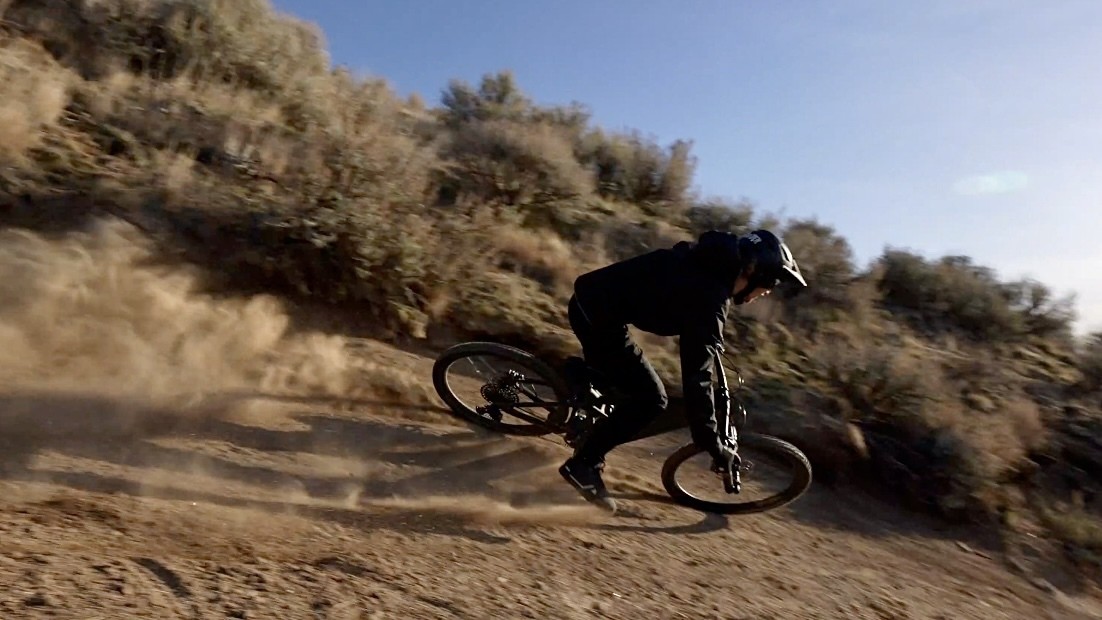
Overall, the range provided by the Repeater’s 630 watt-hour battery allowed us to cover plenty of ground and did not leave us yearning for additional range. Had Transition equipped the Repeater with a larger watt-hour battery, we feel the increase in range would not have outweighed the decrease in handling performance due to the added weight.
Build Kit
Magura MT7 Brakes
Dropping anchor on a full-size e-bike requires a lot of stopping power. Magura’s MT7 brakes take the cake for the strongest brakes we have ridden on an e-bike thus far. The four-piston, four brake pad design combined with Magura’s 203mm MDR rotors offers next-level bite and stopping force. The HC1 lever design has a smooth actuation and controlled modulation that prevents arm pump from occurring. We never experienced any fade or change in the lever throw during long descents and were blown away by the consistent power when riding in the rain and mud. Easily the most impressive component on the Repeater, don’t be surprised if you see a set or two gracing some of our editors’ bikes in the future.

DT Swiss HX1700 Hybrid Wheels
To manage the extra weight and drivetrain forces associated with an e-bike, DT Swiss developed their HX1700 wheelset. The wheels feature an aluminum rim with a 30mm internal width, DT Hybrid 1 reinforced spokes, a hardened steel freehub body, and a redesigned hub shell. On the trail, these e-specific changes provided a solid and smooth ride quality. The wheels were plenty stiff to support the added weight of the Repeater yet still offered enough compliance to not deflect in corners or through rock gardens. And despite plenty of poor line choices and direct impacts with rocks or roots, neither rim has any dents to show. The changes made to the freehub were not as noticeable when riding, but after months of smashing gears under load and riding in wet conditions, we haven’t experienced any issues with the 350 rear hub.

Schwalbe Big Betty Tires
Schwalbe’s Big Betty tire is one of the more aggressive tires in Schwalbe’s lineup, featuring meaty, siped side lugs and square middle knobs spaced generously apart from one another. The Repeater is specced with a Big Betty in the rear, and the traction provided in various conditions was borderline unbelievable. We weren’t even halfway up our first climb before we were shaking our heads, dumbfounded by how easily we had meandered up a muddy, root-riddled trail. Sure, we had a motor assisting us, but the climbs we cleared had more to do with biting into the saturated soil than torque and power. Once back in Boise and riding sandy decomposed granite, we again were impressed by the climbing traction, and side knob bite when leaning into corners. When hauling downhill, Big Betty’s square-edged middle knobs were noticeably more effective at slowing down the mass of the Repeater when compared to other rear tires we’ve tested on e-bikes. The only downside to the Big Betty in the Addix Soft compound is the slow-rolling resistance and lifespan. We are less concerned with rolling resistance on an e-bike but could see going with a firmer, more resilient compound from Schwalbe in the future.
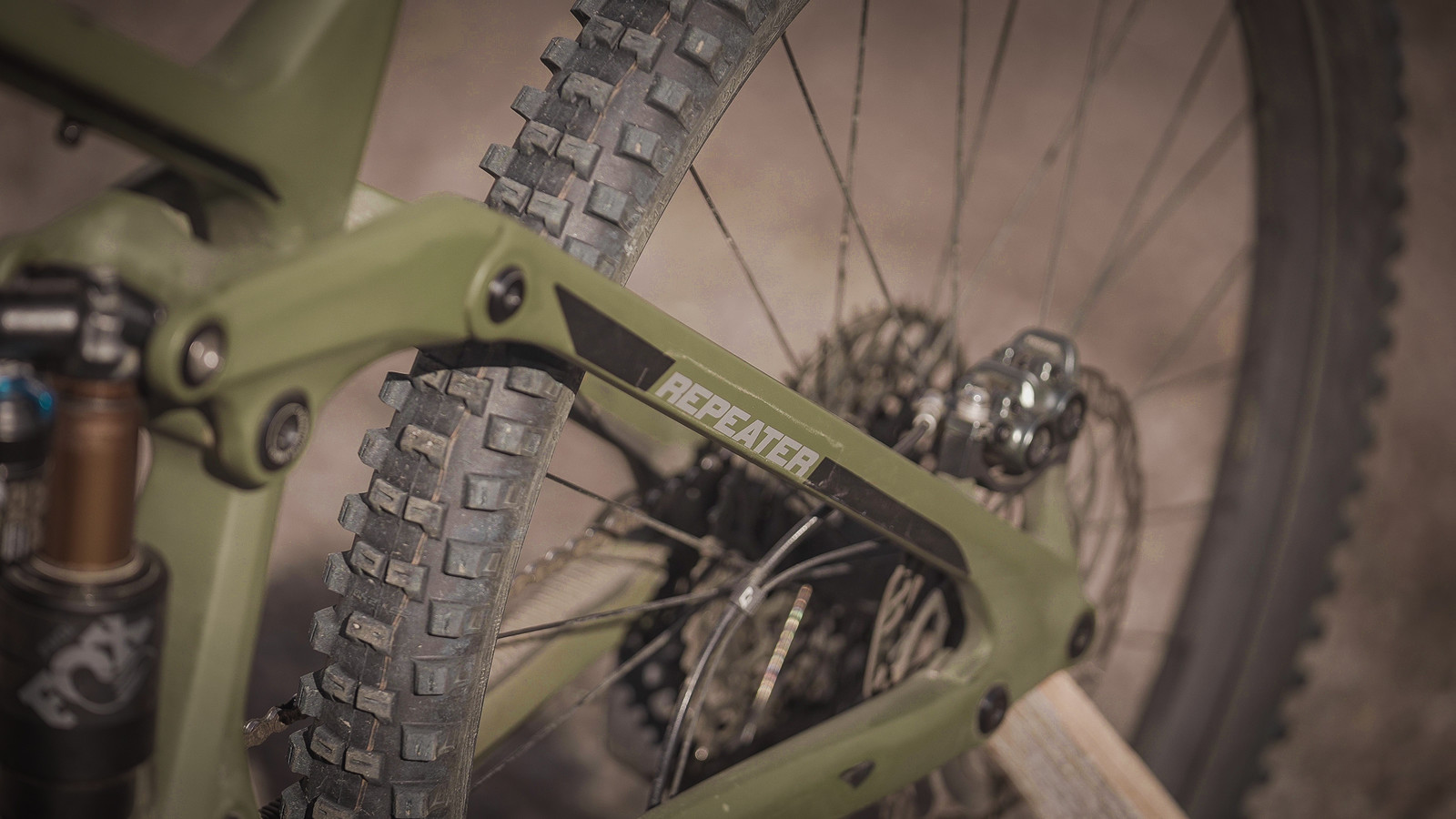
Noise
Like so many e-bikes we’ve tested with Shimano’s EP8 motor, the only sound produced by the Repeater is the familiar knocking noise produced by the motor when not under load. The noise sounds similar to a rear cassette freehub body clang and only occurs when coasting. Shimano is aware of this problem and will likely roll out updates to resolve the issue in the future. The noise won’t be bothersome for some riders, especially if your trails are relatively smooth and damp. However, the constant rattling when flying downhill and the inability to deaden the sound could be a deal-breaker for some.
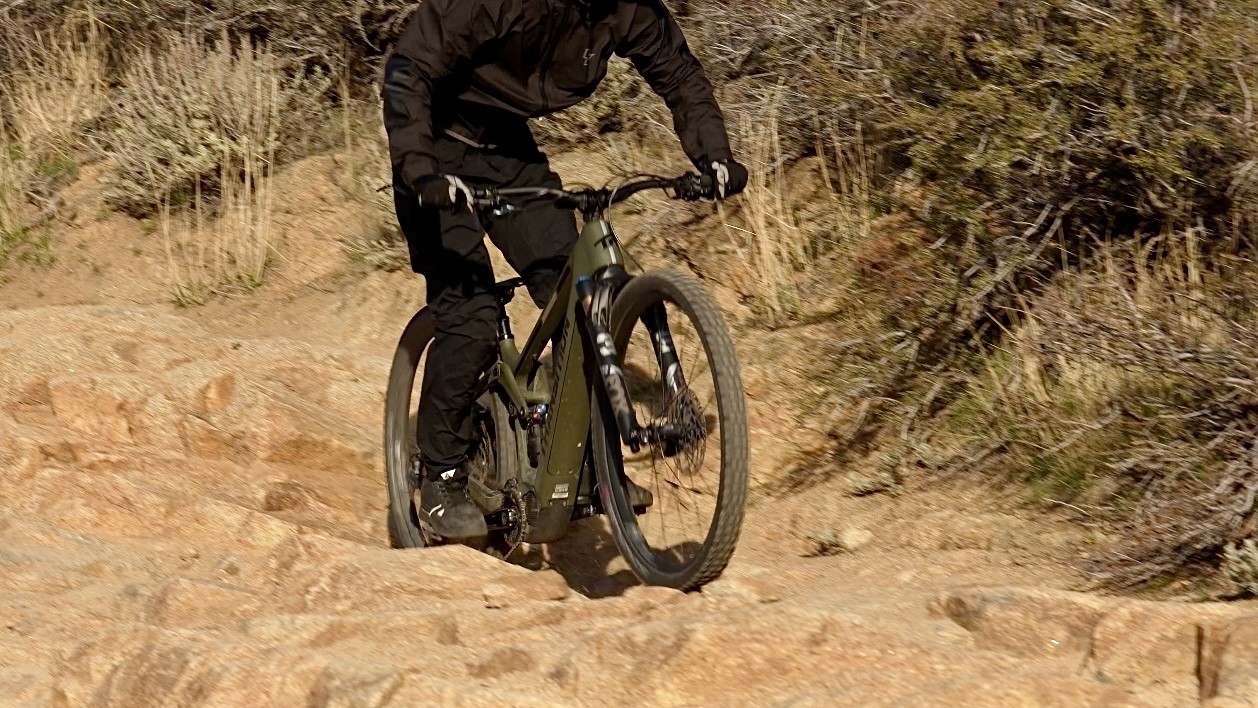
Long Term Durability
We have had the opportunity to spend more time riding our Repeater test bike than we typically receive before a new bike launch. With all of the testing taking place during the wet and muddy winter months, a few areas of concern regarding long-term durability have become apparent. First, the internal cable routing through the headset cover leaves a large opening for water to enter and penetrate the headset bearings. This has caused the lower headset bearing on our Repeater to wear much faster than usual, leading to more resistance when turning the handlebars. We love how organized the cockpit looks with how the cables are routed but would like to see smaller holes or a rubber grommet used to fill up the extra space in the future.

The other area of concern has been the paint job on our Repeater. On the drive side, we have entirely worn through the paint on the rocker link and chainstay from our knee pad and shoe rubbing when pedaling. While this will happen over time to many bikes, we were surprised to see this happen after only a few months of riding. We would urge riders who pick up a Repeater to invest in a vinyl frame wrap protector before heading out to play in the dirt.


What’s The Bottom Line?
The Repeater continues Transition’s legacy of developing well-rounded, capable and confidence-inspiring bikes. With balanced geometry that doesn’t swing too far in any one direction, the Repeater is an excellent performer on any terrain. A stable and planted plowing machine on the descents and a billy goat on the climbs. Transition’s choice to use Shimano’s EP8 motor with a 630 watt-hour battery keeps the Repeater within a manageable weight and gives riders plenty of juice and power to explore. As one of the most comfortable e-bikes we’ve ridden to date, the Repeater is the perfect option for riders looking for an e-bike to facilitate their everyday adventure.
For more information on Transition's Repeater e-bike, please visit www.transitionbikes.com
View key specs, compare e-bikes, and rate the new Transition Repeater in the Vital MTB Product Guide.
About The Tester
Jason Schroeder - Age: 27 // Years Riding MTB: 16 // Height: 6-feet (182cm) // Weight: 168-pounds (76.2kg)
A once-upon-a-time World Cup downhill racer turned desk jockey, Jason has spent years within the bicycle industry from both sides of the tape. A fan of all day adventures in the saddle or flowing around a bowl at the skatepark, he doesn't discriminate from any form of two wheeled riding. Originally a SoCal native now residing in Boise, Idaho, you can find Jason camped out in his van most weekends at any given trailhead in the greater Pacific NorthWest.







View replies to: Transition Repeater Review
Comments